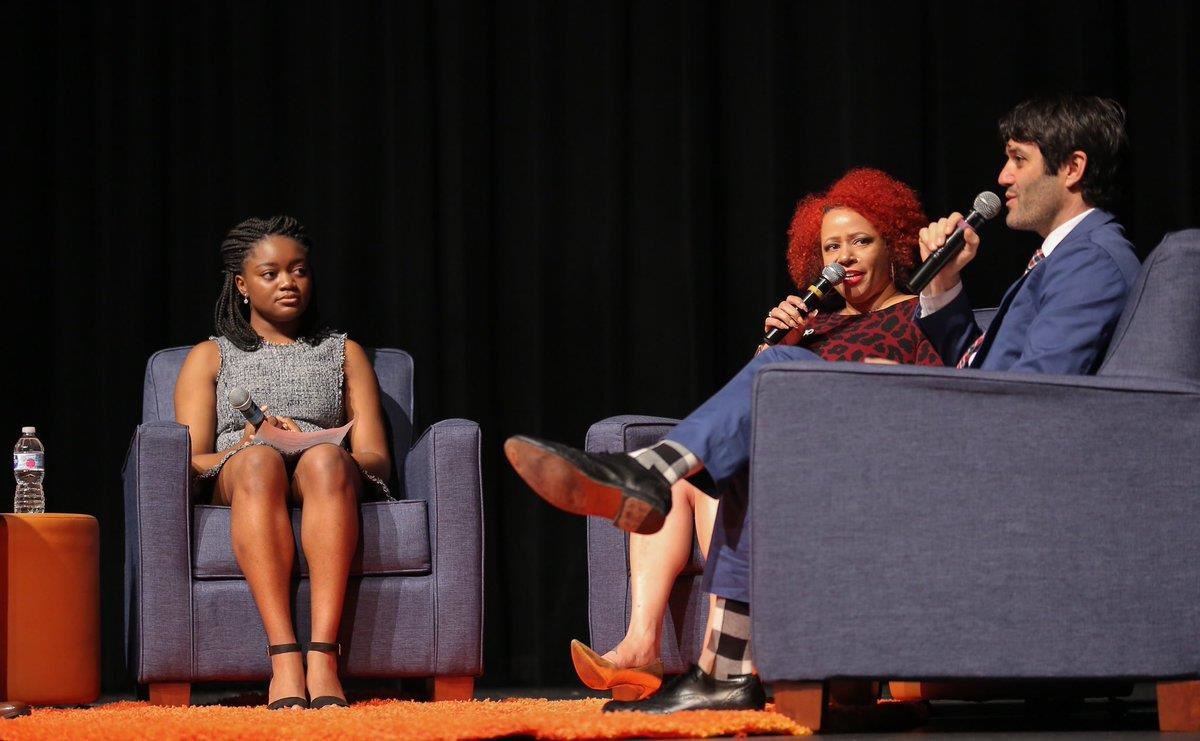- Council of the Great City Schools
- Chicago Students Discuss Slavery with Creator of the N.Y. Times 1619 Project
Digital Urban Educator- October 2019
Page Navigation
- Town Hall Meeting to Focus on the Importance of the 2020 Census
- Eleven Finalists Vie for Top Urban Education Award
- Albuquerque Superintendent to Retire
- 2019 Blue Ribbon Schools Named
- Chicago Students Discuss Slavery with Creator of the N.Y. Times 1619 Project
- Legislative Column
- Iowa Students Quiz Democratic Presidential Contenders
- Indianapolis Police Officer Fulfills Dream of Being a Teacher
- Urban Teachers Receive Presidential Math and Science Awards
- Des Moines High School Welcomes Country's Newest Citizens
- True2 U Mentoring Program Kicks Off in Cleveland
- Great City Grad
Chicago Students Discuss Slavery with Creator of the N.Y. Times 1619 Project
-
The 1619 Project, a stirring collection of writings and photography in The New York Times marking the 400th anniversary of the beginning of American slavery, has been added as a resource to all high schools in Chicago Public Schools.
And students already are responding with works of art, poetry, biographical narratives, even a board game.
“The stories we tell about our nation’s history matter deeply, and the 1619 Project offers us a new set of stories,” Chicago Public Schools’ CEO Janice Jackson wrote in a blog post.
She said every district high school will receive 200-400 copies of the publication, which was produced and distributed by The New York Times in August observing the 400th anniversary of the beginning of American slavery. The first enslaved Africans arrived by ship in late August 1619 at Point Comfort in the British colony of Virginia.

Quoting The Times, Jackson said the project “aims to reframe the country’s history, understanding 1619 as our true founding, and placing the consequences of slavery and the contributions of black Americans at the very center of the story we tell ourselves about who we are.”
At a recent event at Whitney Young High School, Jackson joined Nikole Hannah-Jones, an investigative reporter with The New York Times Magazine, and Jake Silverstein, editor-in-chief of The New York Times Magazine, to discuss the impact of the project and answer questions from students.
The event is available on YouTube (and can be viewed at the end of this article) with an opening sequence featuring artwork created by students who studied the 1619 Project materials in recent weeks. The impact of what they learned seems profound, given the themes they focused on and the subject matter of their art.
On stage, student Rochelle read her poem, titled “Our History,” which at one point asks, “When do I get to enjoy the nation we made?”
Another student, Kennedy, read from the biography she wrote describing the hard life and shocking events experienced by her great-great-grandmother as a slave in Texas.
The idea for the project came from Hannah-Jones. “Part of the reason we felt we had to do the 1619 Project is because we’re taught this history so poorly in our K-12 education. Slavery is taught usually in a very short, separate section. It’s not taught in a way that helps us understand how integral slavery was to our economy, to our political culture, really everything about American life,” she said.
As the program wound down, Jessica, a junior, stood to thank Hannah-Jones and Silverstein for the reporting package. She said she would use what she has learned “to educate not only me and my parents but also my younger sister and my younger cousins who think everything is okay, everything is fine, and you know, black people don’t struggle. But I will be able to show them this newspaper and this magazine and tell them, like, this is what we have been going through, this is what we are going through.”
Jackson said teachers also have access to lesson plans, reading guides and standards-aligned activities developed by the Pulitzer Center to support the project. See https://pulitzercenter.org/lesson-plan-grouping/1619-project-curriculum
A student asked whether the district’s social studies curriculum would be changed “to tell our stories.”
“The short answer is yes,” Jackson responded.
In her blog, Jackson embraced the project. “It is my sincere hope that parents and families explore the project with their children; teachers examine these curricular materials and share it with their students; and principals support staff and students as they tackle this subject,” she wrote.
Media Contact:
Contact Name
Contact@email.com
(000) 000-0000
Contact Name
Contact@email.com
(000) 000-0000
Contact Name
Contact@email.com
(000) 000-0000
Media Contact:
Contact Name
Contact@email.com
(000) 000-0000
Contact Name
Contact@email.com
(000) 000-0000
Contact Name
Contact@email.com
(000) 000-0000


